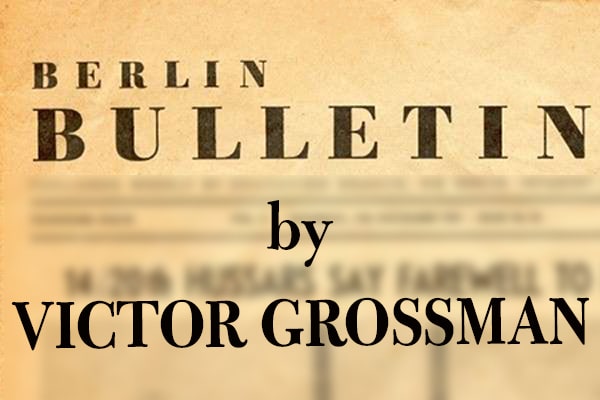by ROBIN BLACKBURN
The claim that Alexander Cockburn practised a new type of radical journalism is one he would probably have disputed, perhaps pointing as precedent to his father Claud’s remarkable exposés in his thirties newsletter, The Week. The machinations of the English ruling-class admirers of the Nazis who aimed to convert appeasement into alliance were first uncovered in The Week, and it was there that they were dubbed ‘The Cliveden Set’. Claud Cockburn rose to tough challenges in a career that ran from The Times to the Daily Worker, from the Roaring Twenties to the height of the Cold War. Claud—and Patricia, Claud’s wife and Alexander’s mother—were certainly a constant source of inspiration to Alexander, as his readers were often reminded. Nevertheless, in the changed conditions of the sixties and seventies, innovation was required to reinvent the journalism of the franc-tireur, often roving behind enemy lines, alert to the infinite varieties of liberal claptrap, and unveiling the real world of Big Money and the National Security State. The Ages of Reagan and Clinton, Bush and Obama, were different from those of Roosevelt, Hitler and Stalin, or the high Cold War; but they bred their own corruptions, poisons and perils. Alexander’s outlaw columns and newsletter, CounterPunch, held the new power elites to account and showed up the conformism of the serious organs of opinion.
Claud Cockburn had had to contend with two decades of fascist advance; but he saw the tide of history turn with organized labour, anti-fascist partisans, the Red Army and colonial independence. Alexander launched into radical journalism in the red sixties but soon had to confront the end of labour’s forward march, Soviet collapse, the rise of the new right and a species of progressivism that embraced the Atlantic establishment’s goals. An extraordinary amnesia developed that allowed supposedly liberal or left-wing writers to become the cheer-leaders for nato expansion and a new version of the West’s civilizing mission. Prior to the crumbling of the ussr Alexander had frequently warned against neo-con ‘threat inflation’; the exaggerations became even more ludicrous following the terrorist attack of 9/11, panicking the public into support for the occupation of Afghanistan and the invasion of Iraq.
In these conditions, Alexander had to be the vanguard and the rearguard rolled into one: at the centre of what was going on, but at a great distance from the petty accommodations of many of his profession, too. He saw himself first and foremost as a working journalist. But though he was the author of some remarkable reportage, this was not his true distinction. Alexander took up his post as sentinel and outrider in an age when star columnists and self-important anchor men had eclipsed mere reporters and editors. The Big Feet distracted the audience from the crimes being perpetrated in full view. If the famous columnists were engineers of consent, Alexander was on hand to reveal their evasions and complicities. Together with a tiny band of brothers and sisters he held the armies of reaction at bay, allowing the forces of renewal time to regroup.
Alexander arrived in the United States in 1972, just about the moment that one sort of left peaked and a new left, based in the social movements, was struggling to be born. In the decade before that Alexander had helped in the early re-shaping of New Left Review, joining the editorial committee and becoming managing editor in 1966. At that point the journal was run by a rather intense collective of less than a dozen editors, meeting for several hours every fortnight. Alexander had a day job as assistant editor at the Times Literary Supplement and then, by about 1967, at the New Statesman. We at nlr were particularly grateful for Alexander’s extraordinary gift for taking an important article and making it readable and memorable. Whether it was a minimal sub-edit or a wholesale make-over, Alexander knew what needed to be done; and did it with such tact and skill that the contributor was invariably grateful. There was something philosophical as well as technical in his approach as editor that foreshadowed his future as a writer.
Alexander did not invest in any opposition between the New Left and the Old; rather, he was pleased when the two were able to come together, as he explained in Seven Days in Seattle (2000), co-written with Jeffrey St. Clair. Without subscribing to any labour metaphysic, he judged the self-proclaimed agents of change by their real impact on working people. In 1966 Alexander and I edited for Penguin and New Left Review a collection entitled The Incompatibles: Trade Union Militancy and the Consensus, which brought together trade-union organizers, leftwing journalists including Paul Foot, Marxist economists and two liberals—Michael Frayn and Philip Toynbee—who mocked the demonization of union activists by Labour as well as Conservative pundits. Jack Jones, the Transport Workers leader who, like Claud Cockburn, had fought in Spain, also contributed. Claud himself helped us to plan the book as well as contributing to it. After one strenuous debate on the limitations of the strike weapon he urged us to put the disagreement in the book rather than strive for a perfectly correct position. Sales were reasonable, not amazing; but the book did register a syndicalist militancy that was to upset three British governments, those of Wilson, Heath and Callaghan.
We followed up with another jointly edited collection, Student Power, which caught the wave in 1968–69 and sold 75,000 copies. In our own undergraduate days we had despised student politics for its frivolity and careerism, but the wave of student occupations in the late sixties, linked to anti-war and labour struggles, was a quite different matter. Alexander, though himself now unconnected to the academy, wrote up a student revolt at the lse in 1967 for nlr. The May events in Paris the following year saw students taking their place in an international anti-colonial and anti-capitalist revolt. Alexander was happy to give this insurgency a helping hand, but university life had no appeal for him. He was after bigger game than was to be found in the seminar room.
In January 1968 Alexander and I attended the Congress of Intellectuals in Havana and jointly submitted a paper on bureaucracy and workers’ control, which drew on an eclectic range of authorities from Weber and Marcuse to Lenin, Isaac Deutscher and Che Guevara. Our argument was that ill-equipped guerrillas in Vietnam were worsting the world’s most advanced military establishment, falsifying Weber’s claim for the superiority of bureaucratic organization. Unfortunately I had to leave the conference early, before we had had time to straighten out some theoretical passages I had drafted or to clinch our critique of Stalinism. As Alexander subsequently recalled, he was left alone to defend some tricky passages in the ‘Blackburn–Cockburn theses’, in which we assailed Weber’s blindness to the true dynamic of history and urged the need to break the suffocating embrace of Brezhnevite officialdom. With the fraternal delegates from the Soviet Writers’ Union glaring at this challenge, Alexander liked to claim that I had thrown him to the mangy Russian wolves—but friends assured me that he defended our case with his customary panache. Five years earlier, Alexander’s first article in nlr, a review of Joseph Heller’s Catch-22, had already offered luminous ideas on bureaucratic militarism and the spirit of capitalism; the issue, nlr 18, also had pieces on both workers’ control and guerrilla warfare. Heller’s book is set in a us airbase during the Second World War, and Alexander highlights the figure of Milo Minderbinder, a quartermaster who, in the spirit of free enterprise, has accepted a lucrative offer from the Germans to bomb his own base, and offers his own account of the ideal relation between capitalism and war: ‘Frankly, I’d like to see the government get out of war altogether and leave the whole field to private industry. If we pay the government everything we owe it, we’ll only be encouraging government control and discouraging other individuals from bombing their own men and planes. We’ll be eliminating their incentive.’ Sixty years later, this has moved beyond parody.
New worlds
In the early seventies Alexander was pondering his move across the Atlantic to the country where the big decisions were being made and new movements being born. Of course Claud had also made this move in the twenties and, like many European leftists, found the us context refreshing. Alexander was long to appreciate the relative ease of communication across class lines in the United States. Even when based mainly in New York he travelled extensively in search of contemporary America. ‘Press Clips’, Alexander’s column at the Village Voice, charted new territory in the skill and detail with which it engaged with the work of journalists in general and the new breed of opinion formers in particular. Alexander saw journalism as a craft or trade and brooked no excuses for those who out of laziness—or cowardice—endorsed the idées reçues of the age.
New Left Review for more








